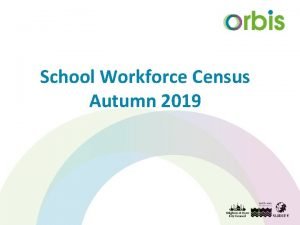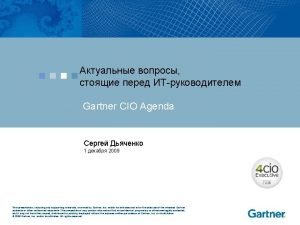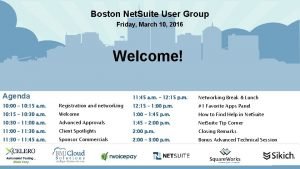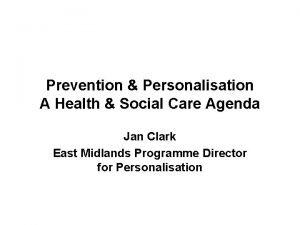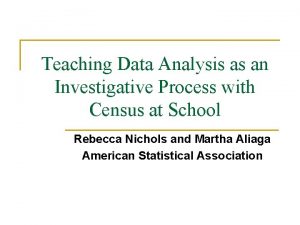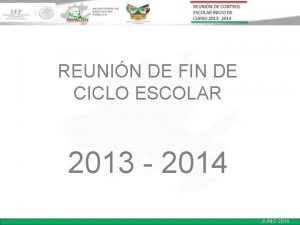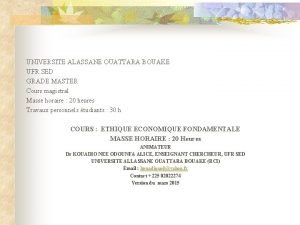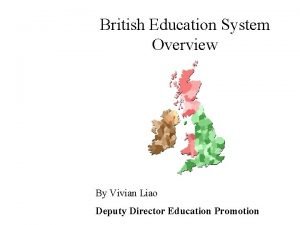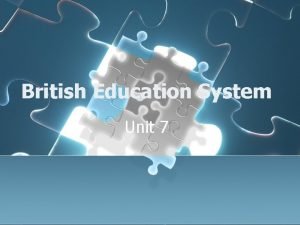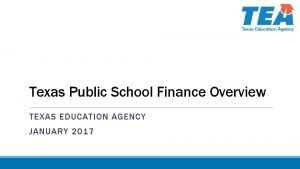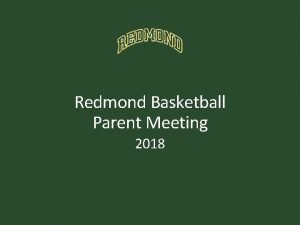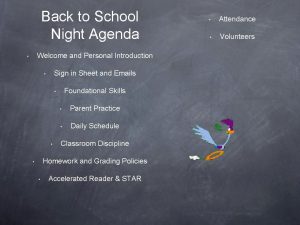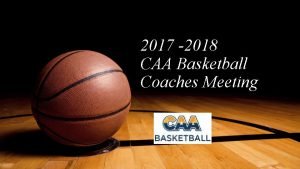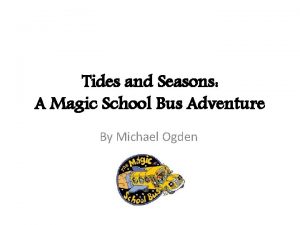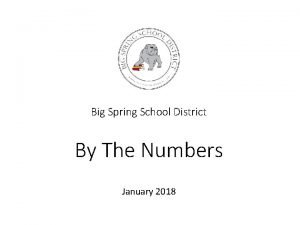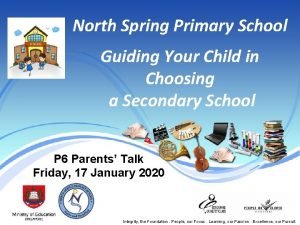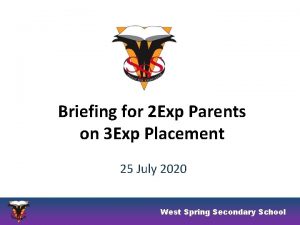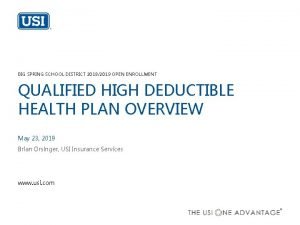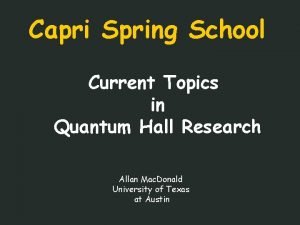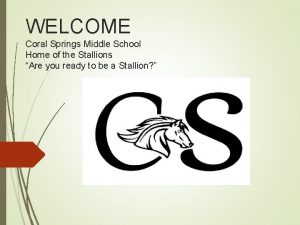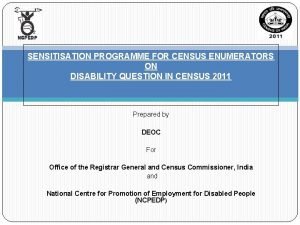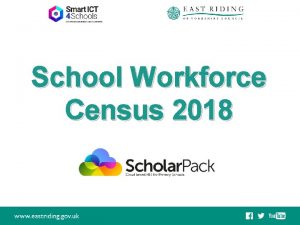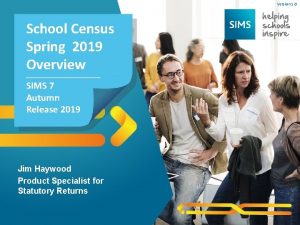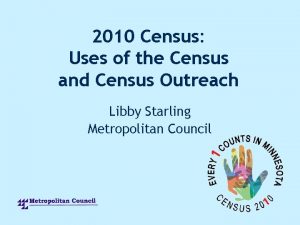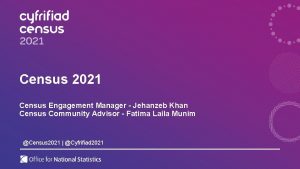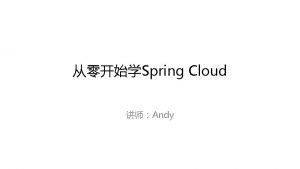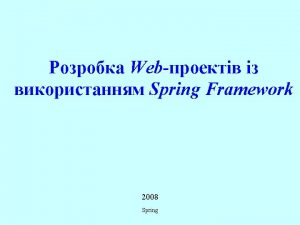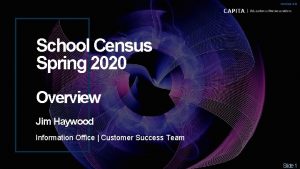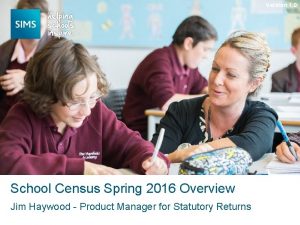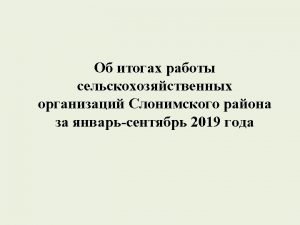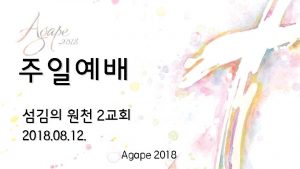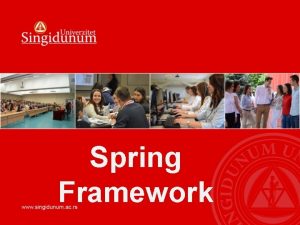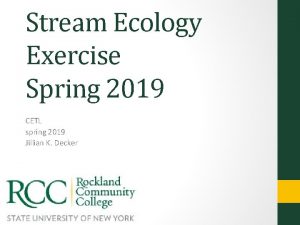Census Spring 2019 Agenda Overview School Census 2018





























- Slides: 29

Census – Spring 2019

Agenda • • Overview School Census 2018 2019 Create and Validate Return Break Identify and analyse validation errors Detail and Summary reports Review how to return the census via COLLECT

Dates for Your Diary • Census date is Thursday 17 th January 2019 • Deadline for returns is Friday 1 st February 2019 • School will require latest SIMS version. • School will need to have applied the latest file set in SIMS.

Census – A Brief History • The School Census involves three collections each year - October, January and May. • October Census is the main census as it is used to gather pupil numbers which are used to determine school budgets. • January Census is used by Df. E to determine Pupil Premium. • May Census collects all pupil and school data and although not used for funding is still important.

Spring 2019 Census - Funding • Information provided to the Df. E via School Census Spring 2019 will be significant to the following funding areas; • The Early Years block of the 2018/19 DSG (Dedicated School Grant) • Deprivation Pupil Premium • Service Child Pupil Premium • Adopted from Care Pupil Premium • Early Years Pupil Premium

What Is Census Data Used For? • Census data is used for / by; – funding purposes – underpins ASP and the performance tables – departmental policy divisions – other government departments – local authorities – external agencies – educational researchers Therefore data accuracy is highly important.

Guidance Notes • The Df. E Guidance Notes define what is collected in the census and why. They can be downloaded from the Df. E website (via link on Czone). • We are issuing Capita Guidance ‘Producing the School Census Spring 2019 Return’. • We will also make available Capita Guidance ‘Preparing for the School Census Spring 2019’, which gives more in depth information on how to prepare your data in preparation for a return. • Guidance notes will be available on the Census and Reports page on Czone.

Early Years Census Recording Question: Where should Early Years provision be recorded? Answer: Schools with onsite early years funded provision make their return via EITHER the School Census OR the Early Years Census, BUT NOT BOTH. – Registered pupils of the school (2, 3 and 4 -year-olds depending on the statutory age range of the school) are recorded via the School Census (and not the Early Years Census) – Children (aged 2, 3 and 4) attending a separate Ofsted registered PVI Provider on a school site, are recorded via the Early Years Census (and not the School Census) – children attending s 27 (Governor run) provision should be either: • recorded via the School Census where they are registered pupils of the school (can include 2 year olds if the school’s statutory age range covers 2 -year-olds); or • recorded via the Early Years Census where they are not registered pupils of the school

Privacy Notices • Under the GDPR May 2018, all schools must inform parents/carers that they hold personal data about each pupil, and explain how the data is used. • Schools need to send the parent/carer of every pupil a Privacy Notice. • Schools should issue the Privacy Notice as part of their general publications and communications. E. g. Induction pack, school diary, School Prospectus. • It could also be posted on the school notice board, school website and/or learning platform.

Privacy Notices – Changes May 2018 • The Data Protection Act 1998 was replaced by the GDPR (General Data Protection Regulation) on the 25 th May 2018. • Schools will need to review their privacy notices to ensure they are compliant with the requirements of the GDPR. • There administrative fines for failing to comply with the GDPR. • For more information please refer to Czone, the Virtual Schoolbag or contact the Information Governance Team at CS. DPA@eastsussex. gov. uk

School Childcare • A school can indicate up to four types of childcare – Before School Childcare (B) – After School Childcare (A) – Holiday Childcare (H) – Under Five Childcare (U) • A school can indicate up to three different sites for childcare – On Site – Off Site, Signposted – Off Site, Not Signposted

Unique Pupil Numbers (UPN) • All pupils must have a Unique Pupil Number. • Pupils entering the maintained sector for the first time need to have a UPN issued by SIMS. Please do not use temporary UPNs. • However, any pupil that has previously been in a maintained school should already have a UPN, so please do not issue a new one. • If the previous school can’t supply the UPN, the Local Authority should be able to, as we can access the National Pupil Database. • Please contact us by Secure Email at: cs. data. management@eastsussex. gov. uk

Unique Learner Numbers (ULN) • ULNs are required for pupils on roll on census day aged 14 and over. • Schools should be registered with the Learning Records Service (LRS). If not, will need to register. • Schools obtain ULNs by creating and uploading a CTF to the School to School (S 2 S) system. • The Learning Records Service (LRS) requires a pupil’s postcode in order to issue a ULN, (postcode is held in SIMS). • https: //www. gov. uk/government/publications/lrs-uniquelearner-numbers

Youth Support Services Agreement • This data item (used to be known as Connexions Assent) can be found in the Additional Information tab of the Student Details. • Schools are legally required to pass information to the Youth Support Service for pupils on or approaching the age of 13. • Parents (or pupils) can opt out of this arrangement in respect of data other than names, dates of birth and addresses. The Privacy Notices include a section on Youth Support Services which inform parents (and pupils) of their right to opt out. • If the parents/pupil opt out, must be recorded in SIMS. Any reports from the census data can then take that into account.

Top-up Funding Indicator • This relates to EHCP pupils on roll, on census day for whom a school receives top-up funding from the Local Authority. • EHCP pupils who are in the following bands are the ones for whom top-up funding is received. – Sustained and Comprehensive Support A or B – Significant Personalised Support A or B – Exceptional Case Funding • Schools receive a monthly School Revenue Report which includes a High Needs tab which lists the Statemented/EHCP pupils by band. • All pupils in special facilities would be deemed to be receiving top-up funding.

Post Looked After Arrangements • This relates to pupils on roll on census day who were looked after immediately before adoption, or being placed on a Special Guardianship (SGO), Residence Order (RO) or Child Arrangement Order (CAO). • It will be up to those who have parental responsibility to decide if they wish notify schools whether their children come under any of these categories. • The Pupil Premium Plus of £ 2300 per pupil will be paid for any pupils recorded in the census as Post Looked After, previously “Adopted from Care”.

Free School Meals Eligibility (FSM) • NOT to be confused with School Meal Taken (UIFSM)! • The Df. E use it for the pupil premium, £ 1320 per primary pupil and £ 935 per secondary pupil this year. • The FSM Team in Children’s Services send a full list of eligible pupils via Any. Comms at the beginning of each term. • Any changes to this, eligibility start and stop, are sent out (also via Any. Comms) every Friday. • Check these lists carefully and amend SIMS accordingly as soon as you receive a change. • The Pupil Premium will be paid for any pupil who has been eligible under the ‘Ever 6’ arrangements.

FSM changes following Universal Credit • Following the roll out of Universal Credit, pupils who were in receipt of FSM at 31 st March 2018 will continue to be FSM eligible until the end of Universal Credit roll out (estimated Summer 2023) or until the end of their school phase, even if their circumstances change. • It is important that the FSM eligibility list produced by FSM team is checked and SIMS updated to reflect the start and end dates, if applicable, in this list. • It is not expected that FSM end dates will be entered during this transitional stage but there may be some exceptions that will be recorded in the FSM eligibility lists.

Service Children • These are children whose parents are Service personnel serving in regular HM Forces military units. • Indicator is now collected from all census returns, not just January. • Pupil premium of £ 300 per year is paid for pupils in year groups Reception to Year 11, recorded as Ever 6 Service Child or in receipt of a Child Pension from the Ministry of Defence.

Disability Access Fund Indicator • The Disability Access Fund (DAF) Indicator records for eligible pupils aged 3 and 4, the receipt of DAF funding. • 3 and 4 year olds will be eligible for the DAF if they meet the following criteria: – the child is in receipt of child Disability Living Allowance AND – the child receives free early education

EYPP – Which Pupils? • Schools can access EYPPR pupil eligibility from EYEE Online Nursery Provider Portal • Early Years Census Team will have provided Children’s Services with a list of pupils EYPP eligible as at October Early Years census. • Do not assume that eligibility to funded hours means they are entitled to EYPP • Df. E expect schools to report pupils in RECEIPT of EYPP

Early Years Pupil Premium • Children will be eligible for EYPP in East Sussex if they are receiving; • funded hours of early education • are in NC year N 1 or N 2 AND • meet the benefits related criteria for Free School Meals (Please note: meals delivered as part of the Universal Infant Free School Meal – UIFSM entitlement are not FSM) RECEIPT of EYPP to be recorded (not eligibility as previously)

Extended Childcare Hours • Extended Childcare Hours - For three and four-year-old pupils with working parents with a valid 30 -hour code. • This new field records the take up of the additional 15 hours of childcare • 30 -Hour Code Indicator - For three and four year old pupils, the 30 -hour code indicator confirms the eligibility of working parents to access the additional 15 hours of extended childcare

Hours for Early Years Pupils • Funded Hours relate to pupils who are funded under the free entitlement to education for under 5’s. • Hours at Setting are the number of hours the same pupils spent in education provision at the school irrespective of who funded the hours. • The Hours at Setting cannot therefore be less than the Funded Hours.

Funded Hours • All 4 year olds (i. e. reception pupils) in East Sussex are entitled to be full-time so schools do not need to record the hours. • Funded hours should be recorded for pupils aged 2, 3 and 4 in nurseries or in year groups E 1, E 2, N 1 and N 2 with a maximum of 15 hours per week. • Funded hours cannot exceed Hours at Setting.

Hours at Setting • There is no maximum number of Hours at Setting for 2, 3 and 4 year olds. So this figure can exceed the Funded Hours • Schools will generally record the same number of hours for 2, 3 and 4 year olds as for Funded Hours funded under the free entitlement (EYEE) + Any additional hours funded from other sources (E. g. Parents) = Hours at Setting

UIFSM – School Dinner Taken • The School Dinner Taken panel records which pupils have taken a Universal Infant Free School Meal (UIFSM) on census day. • The collection is restricted to pupils in Reception, Y 1 and Y 2 (and those aged 4 – 6, not taught in a National Curriculum Year in Special Schools). • This informs the Df. E of take up, and influences future payments.

…and now Time to produce your return using your live school data…

Thank you. Any questions?
 School workforce census 2019
School workforce census 2019 Spring framework overview
Spring framework overview Agenda sistemica y agenda institucional
Agenda sistemica y agenda institucional Kim ki duk spring summer fall winter
Kim ki duk spring summer fall winter Spring summer winter fall
Spring summer winter fall Gartner cio agenda 2018
Gartner cio agenda 2018 Suiteworld 2018 agenda
Suiteworld 2018 agenda Personalisation agenda 2018
Personalisation agenda 2018 Dada la siguiente secuencia rusia 2018 rusia 2018
Dada la siguiente secuencia rusia 2018 rusia 2018 Census at school random sampler
Census at school random sampler School workforce census 2017
School workforce census 2017 Conest hidalgo 2021
Conest hidalgo 2021 Resultat ufr sed 2018-2019
Resultat ufr sed 2018-2019 Texas recapture districts
Texas recapture districts British school system
British school system British school system overview
British school system overview Texas public school finance overview
Texas public school finance overview Basketball parent meeting powerpoint
Basketball parent meeting powerpoint High school freshman orientation agenda
High school freshman orientation agenda Back to school night agenda
Back to school night agenda High school coaches meeting agenda
High school coaches meeting agenda Http://space-facts.com/the-moon/
Http://space-facts.com/the-moon/ Big spring school district
Big spring school district Myskillsfuture primary
Myskillsfuture primary West spring secondary school
West spring secondary school Big spring school district
Big spring school district Capri spring school
Capri spring school Coral spring middle school
Coral spring middle school 2018 virginia tech high school programming contest
2018 virginia tech high school programming contest Census disability question
Census disability question
